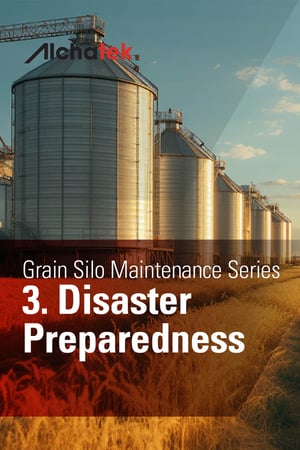 Preparing for the Unpredictable: The Role of Maintenance in Disaster Readiness
Preparing for the Unpredictable: The Role of Maintenance in Disaster Readiness
Natural disasters such as floods, hurricanes, and earthquakes can wreak havoc on grain silos, leading to catastrophic losses. While no one can prevent these events, proper maintenance and preparation can mitigate their impact. A well-prepared grain silo can withstand the forces of nature more effectively, safeguarding both the stored grain and the investment in the infrastructure.
Enhancing Disaster Resilience Through Maintenance
Natural disasters pose a significant threat to grain silos, affecting both their structural integrity and operational efficiency. While it's impossible to control these events, a focus on maintenance can mitigate their impact. One of the most effective ways to prepare for various types of natural disasters is to ensure the silo is well-sealed against leaks and that its foundation is level and stable. Polyurethane serves as a versatile material in this regard, offering both waterproofing and leveling capabilities.
Sealing leaks in the lower sections of the silo is crucial, especially in areas prone to flooding. A waterproof seal prevents water ingress, reducing the risk of structural and electrical damage. Similarly, a well-leveled foundation enhances the silo's overall stability, making it more resilient to the forces exerted by strong winds or seismic activity.
Regular maintenance checks should include a comprehensive review of these aspects. Inspect the condition of seals and the level of the foundation and hire qualified contractors to make necessary repairs. These checks should also extend to auxiliary systems like drainage and backup power, ensuring they are in optimal condition to support the silo during adverse events.
By incorporating these considerations into your regular maintenance activities, you can significantly enhance the disaster resilience of your grain silo. This proactive approach not only safeguards the stored grain but also protects the investment in the facility and ensures the safety of personnel.
The Interplay of Maintenance and Disaster Preparedness
Routine Checks and Seasonal Adjustments
Regular maintenance checks should include disaster preparedness measures. For instance, before the start of hurricane or tornado season, additional inspections can focus on wind resistance features and backup systems. Similarly, before the rainy season, drainage systems should be cleared, and flood prevention measures inspected.
The Value of Expert Consultations
Consulting with experts in disaster preparedness can provide valuable insights into potential vulnerabilities and recommend effective mitigation strategies. These consultations can be part of the annual maintenance routine, ensuring that the silo is always prepared for the worst.
Safeguarding Investments Through Preparedness
Disaster preparedness is not just about avoiding loss; it's about safeguarding an investment in grain storage infrastructure. By incorporating disaster-specific considerations into regular maintenance activities, grain silo owners and operators can enhance the resilience of their facilities. This proactive approach not only protects the stored grain but also ensures the safety of personnel and the community at large. Through meticulous planning and regular upkeep, the devastating impacts of natural disasters can be significantly mitigated, ensuring the long-term viability of grain storage operations.




